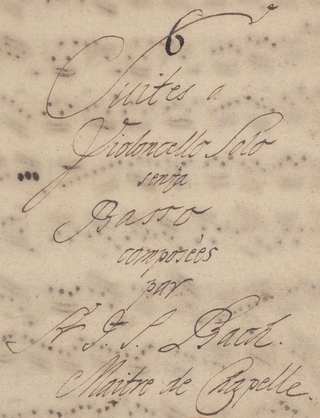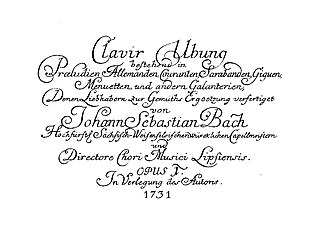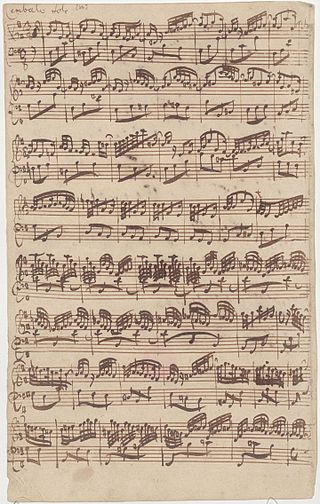
A suite, in Western classical music, is an ordered set of instrumental or orchestral/concert band pieces. It originated in the late 14th century as a pairing of dance tunes and grew in scope to comprise up to five dances, sometimes with a prelude, by the early 17th century. The separate movements were often thematically and tonally linked. The term can also be used to refer to similar forms in other musical traditions, such as the Turkish fasıl and the Arab nuubaat.

The six Cello Suites, BWV 1007–1012, are suites for unaccompanied cello by Johann Sebastian Bach (1685–1750). They are some of the most frequently performed solo compositions ever written for cello. Bach most likely composed them during the period 1717–1723, when he served as Kapellmeister in Köthen. The title given on the cover of the Anna Magdalena Bach manuscript was Suites à Violoncello Solo senza Basso.

The sonatas and partitas for solo violin are a set of six works composed by Johann Sebastian Bach. They are sometimes referred to in English as the sonatas and partias for solo violin in accordance with Bach's headings in the autograph manuscript: "Partia" was commonly used in German-speaking regions during Bach's time, whereas the Italian "partita" was introduced to this set in the 1879 Bach Gesellschaft edition, having become standard by that time. The set consists of three sonatas da chiesa in four movements and three partitas in dance-form movements. The 2nd Partita is widely known for its Chaconne, considered one of the most masterly and expressive works ever written for solo violin.

The Partita in D minor for solo violin by Johann Sebastian Bach was written between 1717 and 1720. It is a part of his compositional cycle called Sonatas and Partitas for Solo Violin.

The Partitas, BWV 825–830, are a set of six keyboard suites written by Johann Sebastian Bach, published individually beginning in 1726, then together as Clavier-Übung I in 1731, the first of his works to be published under his own direction. They were, however, among the last of his keyboard suites to be composed, the others being the six English Suites, BWV 806-811 and the six French Suites, BWV 812-817, as well as the Overture in the French style, BWV 831.

Élisabeth Claude Jacquet de La Guerre was a French musician, harpsichordist and composer.

The English Suites, BWV 806–811, are a set of six suites written by the German composer Johann Sebastian Bach for harpsichord and generally thought to be the earliest of his 19 suites for keyboard, the others being the six French Suites, the six Partitas and the Overture in the French style. They probably date from around 1713 or 1714.

The French Suites, BWV 812–817, are six suites which Johann Sebastian Bach wrote for the clavier between the years of 1722 and 1725. Although Suites Nos. 1 to 4 are typically dated to 1722, it is possible that the first was written somewhat earlier.
Robert de Visée was a French lutenist, guitarist, theorbist and viol player at the court of the kings Louis XIV and Louis XV, as well as a singer and composer for lute, theorbo and guitar.
Johann Paul von Westhoff was a German Baroque composer and violinist. One of the most important exponents of the Dresden violin school, he was among the highest ranked violinists of his day, and composed some of the earliest known music for solo violin. He worked as musician and composer as a member of Dresden's Hofkapelle (1674–1697) and at the Weimar court (1699–1705), and was also active as a teacher of contemporary languages.
Bach: Unaccompanied Cello Suites Performed on Double Bass is an album released by the double bass virtuoso Edgar Meyer. Meyer plays three of JS Bach's Cello Suites BWV 1007-1012. Performing cello suites on a double bass offers intriguing challenges. Meyer recorded Suites I, II and V. There also are recordings of all six Suites by Richard Hartshorne, Gerd Reinke and François_Rabbath. Gary Karr recorded Suites IV, V and VI.
The Overture in the French style, BWV 831, original title Ouvertüre nach Französischer Art, also known as the French Overture and published as the second half of the Clavier-Übung II in 1735, is a suite in B minor for a two-manual harpsichord written by Johann Sebastian Bach.

The term galanteries is sometimes used for movements in the Baroque dance suite whose inclusion is variable, unlike the fixed core of allemande, courante, sarabande and gigue. These pieces usually follow the sarabande.
Charles Dieupart was a French harpsichordist, violinist, and composer. Although he was known as Charles to his contemporaries according to some biographers, his real name was actually François. He was born in Paris, rue aux Ours, August 10th, 1676. His father was Nicolas Dieupart an ordinary musician to Louis XIV's Grande Ecurie. At some point, he befriended Elizabeth Wilmot of Rochester, countess of Sandwich, and Jacques Paisible who were visiting James II of England in his exile at Saint-germain-en-Laye near Paris. This is the main reason for his coming to London around 1700. A prominent member of the Drury Lane musical establishment, Dieupart was active both as composer and performer and actively participated in the musical life of the city. However, after about 1712 he earned his income mostly by teaching, and in his later years lived in poverty. He is best remembered today for a collection of six harpsichord suites which influenced Johann Sebastian Bach's English Suites.

Baroque music refers to the period or dominant style of Western classical music composed from about 1600 to 1750. The Baroque style followed the Renaissance period, and was followed in turn by the Classical period after a short transition. The Baroque period is divided into three major phases: early, middle, and late. Overlapping in time, they are conventionally dated from 1580 to 1650, from 1630 to 1700, and from 1680 to 1750. Baroque music forms a major portion of the "classical music" canon, and is widely studied, performed, and listened to. The term "baroque" comes from the Portuguese word barroco, meaning "misshapen pearl". The works of George Frideric Handel and Johann Sebastian Bach are considered the pinnacle of the Baroque period. Other key composers of the Baroque era include Claudio Monteverdi, Domenico Scarlatti, Alessandro Scarlatti, Alessandro Stradella, Tomaso Albinoni, Johann Pachelbel, Henry Purcell, Antonio Vivaldi, Georg Philipp Telemann, Jean-Baptiste Lully, Jean-Philippe Rameau, Marc-Antoine Charpentier, Arcangelo Corelli, François Couperin, Johann Hermann Schein, Heinrich Schütz, Samuel Scheidt, Dieterich Buxtehude, Gaspar Sanz, José de Nebra, Antonio Soler, Carlos Seixas and others.
Musicalische Ergötzung is a collection of chamber music by Johann Pachelbel. Published during his lifetime, it contains six suites for two violins and basso continuo.
The Suite in G Minor, BWV 995, was transcribed for lute by composer Johann Sebastian Bach between the spring of 1727 and the winter of 1731 from his own Cello Suite No. 5, BWV 1011. It is in six movements:
The Partita No. 1 in B minor BWV 1002 by Johann Sebastian Bach, is a piece for solo violin composed by 1720. This partita is formed in the traditional way that consists of an allemande, a courante, sarabande and gigue in the baroque style, except that this work substitutes a bourrée for the more typical gigue. Also, each movement is followed by a variation called double in French, which elaborates on the chords of the prior movement. The movements in order are:

Partita for keyboard No. 4 in D Major, BWV 828, is a keyboard suite by Johann Sebastian Bach, originally dated 1728. It is the fourth suite in his Clavier-Übung I.

The Partita for keyboard No. 6 in E minor, BWV 830, is a suite of seven movements written for the harpsichord by Johann Sebastian Bach. It was published in 1731 both as a separate work and as part of Bach's Clavier-Übung I.









